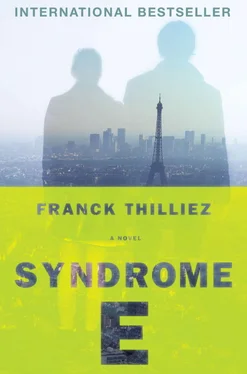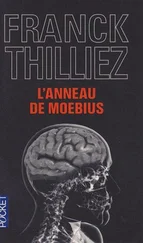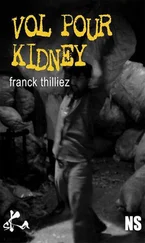Onscreen, the images passed in slow succession. The headphones on the patients’ ears became more refined, the waiting lines on gurneys grew longer, the faces wilted.
“As you can see, Sanders equipped the rooms with loudspeakers that broadcast the same sentences over and over. He called them ‘sleep rooms.’ Those lines of gurneys represent the wait for electroshock. Patients were subjected to treatments three times a day, for periods of up to eight weeks. Three times a day, miss. Thousands of volts coursing through your body. Can you imagine the damage something like that could do to your nerves, heart, and brain?”
“I can imagine perfectly well.”
“Sanders literally wanted to cleanse the brain of its illness. No one on his devoted staff dared question his orders, for fear of losing their job. Sanders was a cold man, authoritarian and devoid of compassion.”
“Are you telling me that no one, in his entire department, ever spoke out? They just let him do what he wanted?”
“Not only let him do it, but assisted. They obeyed, pure and simple.”
Lucie felt her blood boil. It had happened: dozens of doctors, nurses, and psychiatrists who had blindly followed the orders of a madman, even though it flew in the face of their oaths and beliefs. Fear, pressure, and the vile orders of a superior authority in a white lab coat had muzzled them. Lucie couldn’t help making a connection with the famous Milgram experiment, a tape of which she had seen once on the Web. Submission to an absolute authority, which let a human being abandon himself to his basest instincts.
“Sanders truly believed in these barbaric techniques. He held conferences, and even wrote a book called Psychic Driving —you can still find a copy now and then. The most illustrious doctors came to hear him lecture. It was at that point, at the beginning of the 1950s, that the CIA got in touch with him. The agency was strongly interested in his techniques and his writings. It secretly integrated him into Project MK-Ultra, and for years provided the funding for him to pursue his brainwashing experiments at the hospital. And that’s how MK-Ultra entered Canadian territory.”
“Is Sanders still alive?”
“No, he died of a heart attack in 1967.”
“And what about the lawsuit?”
“Despite countless motions to dismiss by the CIA, threats, influence peddling, and claims that this was all protected under the military secrets restrictions, we did prevail. The CIA admitted its involvement in the experiments conducted in Canada and at Allan Memorial. The victims received financial compensation, but much more important than that, they had gotten justice and recognition. For Joseph Rauth and myself, the matter was finally over. We had gotten to the bottom of MK-Ultra and the CIA had admitted its mistakes. Case closed. And what a case…”
Rotenberg remained frozen in place, his eyes on the floor. On the computer screen, the old black-and-white photos continued to parade by. The hospital rooms at McGill were now equipped with televisions hanging nine feet from the patients’ impassive gazes. The retired attorney pressed PAUSE.
“I pursued a brilliant career with Joseph, who died in the late nineties. I handled some terrific little cases, but nothing that ever matched the scope of that one.”
“Forgive me, but… I still don’t see how this relates to the film, or to Lacombe or the Duplessis Orphans.”
Rotenberg nodded.
“I was just getting to that. Some thirty years after the Sanders case, I received a phone call from Belgium. This was about two years ago.”
“Vlad Szpilman?”
“Yes. The man knew my career and everything related to the American intelligence agency, government affairs, and so on. He was a real history and geopolitics buff. He claimed to have revelations about experiments conducted in Canada on children in the fifties. Based on everything he’d read about MK-Ultra, he suspected the CIA was involved. At first I didn’t believe it. I figured he was either some kook or another conspiracy theorist—those nuts had been coming out of the woodwork ever since the 1977 case. To get rid of him, I told him he was on the wrong track, that all the agency’s misdeeds had been brought to light, and that children had never been involved in their brainwashing program. So he e-mailed me a black-and-white photo taken from a film, asking me to call back if I was interested.”
Lucie clenched her fists.
“The photo of the children and the rabbits, is that right? ‘The start of the whole thing’—wasn’t that what you said on the phone?”
“Exactly. I can still see that room spattered with blood, those little girls in hospital pajamas, standing passively in the midst of all that carnage. An extremely disturbing picture. So I called him back, my curiosity aroused. He didn’t want to send me the reel, but asked me to go over there, to see it at his house. I knew I was dealing with someone extremely suspicious, even paranoid, and remarkably intelligent. Two days later, I was at his place in Liège. He brought me into his projection room, and that’s when I saw the film. The original and the one hidden inside it, which the old man had been able to reconstruct thanks to some contacts he had in neuromarketing.”
Lucie listened attentively. The contact was probably the former boss of Georges Beckers, the jowly little Belgian who had persuaded Kashmareck to watch the film in an MRI scanner.
“From the very first image, I knew it was all true. It was like a certainty for me.”
“Why such a certainty?”
He nodded toward the computer screen.
“It’s all there in front of you. The relation between Szpilman’s film and what happened in the hospital rooms at McGill. The undeniable link, the connection between the Duplessis Orphans and the CIA.”
He closed PowerPoint and glided his mouse onto the AVI file.
“I’m going to show you the kind of video the CIA manufactured, which Sanders played in a continuous loop for his patients to wash their brains. But first I have to finish telling you what happened with Szpilman in Belgium. After that disturbing show, he started talking to me about mass hysteria…”
Lucie’s chest grew tighter and tighter. She was hanging on Rotenberg’s every word.
“The man was a veritable walking encyclopedia. He thought he’d found a connection among… several major outbreaks of violence that had helped shape the last century. According to him, the doctor behind the rabbit experiment was not Sanders, and the program wasn’t MK-Ultra, but a parallel program, something even more covert, whose goal had nothing to do with brainwashing.”
“So what was this program about, then?”
“Hold on—it gets better. At that point, Vlad ran to his library and brought out a batch of unpublished photos of the Rwandan genocide, which he’d gotten directly from a photojournalist he’d managed to contact. And he told me about something utterly staggering: mental contamination.”
“Mental contamination?”
“Yes, that’s right. Something that can be transmitted through the eye, and that is so violent that it actually alters the structure of the brain.”
Lucie reacted right off the bat.
“A friend of mine, Ludovic Sénéchal, completely lost his sight after watching that film. It’s called hysterical blindness. The images made his brain malfunction. Is that the kind of thing you’re talking about?”
“It’s much worse than that. Hysterical blindness is a purely psychological phenomenon. In the case of mental contamination, not only is the brain structure modified—I mean physically modified—but, worse, a chain reaction spreads from person to person, like a virus. You’ll see what I mean. Just give me a second…”
Читать дальше












